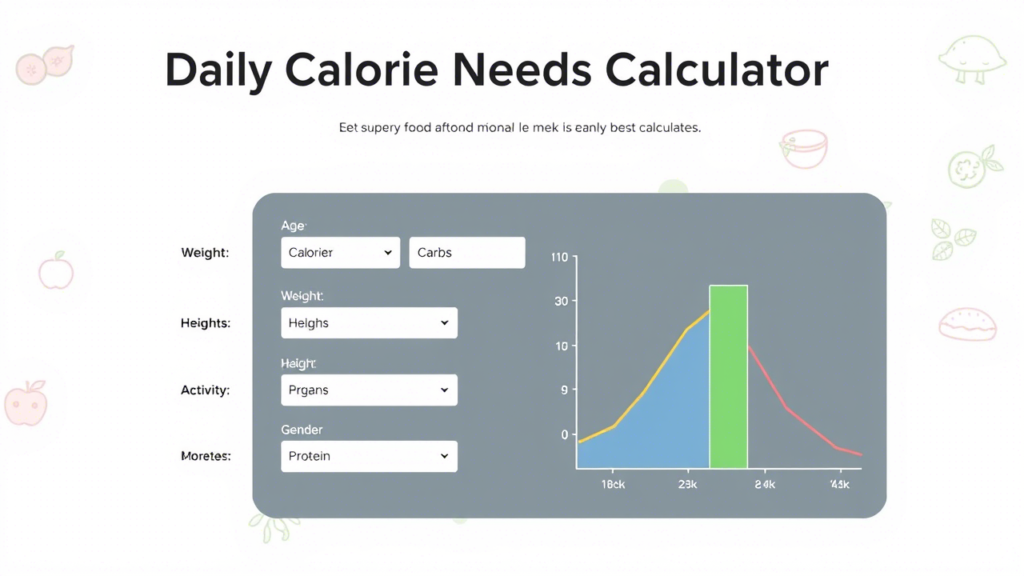Daily Calorie Needs Calculator
This estimate includes your basal metabolic rate (BMR) and activity expenditure
± 200 calorie accuracy margin for individual variations
Why Your Daily Calorie Needs Matter

Related Calculatot
Whether you want to lose weight, build muscle, or maintain your current physique, understanding your daily calorie needs is the foundation of effective nutrition. The Daily Calorie Needs Calculator from EducalcTool.com simplifies this process by estimating your Total Daily Energy Expenditure (TDEE)—the calories your body burns daily. In this guide, we’ll explain how the tool works, how to interpret results, and how to tailor your intake for fitness success.
What Is a Daily Calorie Needs Calculator?
This tool calculates your TDEE using factors like age, gender, weight, height, activity level, and fitness goals. It applies scientifically validated formulas such as the Harris-Benedict Equation and Mifflin-St Jeor Formula to provide personalized calorie recommendations for:
- Maintenance: Calories to stay at your current weight.
- Weight Loss: A safe deficit (typically 500–750 calories/day).
- Muscle Gain: A surplus to support growth (250–500 calories/day).
EducalcTool.com’s calculator also breaks down macronutrient ratios (carbs, protein, fat) for balanced nutrition.
How to Use the Daily Calorie Needs Calculator
- Enter Basic Info: Age, gender, weight (kg/lbs), and height (cm/ft).
- Select Activity Level:
- Sedentary (little/no exercise)
- Lightly Active (1–3 days/week)
- Moderately Active (3–5 days/week)
- Very Active (6–7 days/week)
- Athlete (twice daily training)
- Choose Your Goal: Maintain, lose, or gain weight.
- Get Your Result: See daily calorie needs and macros.
Example:
- Gender: Female
- Age: 35
- Weight: 68 kg (150 lbs)
- Height: 165 cm (5’5”)
- Activity: Moderately Active
- Goal: Lose 0.5 kg (1 lb) per week
- Result: ~1,900 calories/day (Maintenance: 2,400; Deficit: 1,900).
The Science Behind Calorie Calculations
EducalcTool.com uses two gold-standard formulas:
- Harris-Benedict Equation:
- Men:
BMR = 88.362 + (13.397 × weight in kg) + (4.799 × height in cm) – (5.677 × age) - Women:
BMR = 447.593 + (9.247 × weight in kg) + (3.098 × height in cm) – (4.330 × age)
- Men:
BMR (Basal Metabolic Rate) is multiplied by an activity multiplier to get TDEE.
- Mifflin-St Jeor Formula:
- Updated version for improved accuracy, especially for lean individuals.
Understanding TDEE: Total Daily Energy Expenditure
Your TDEE comprises:
- BMR (60–70%): Calories burned at rest for vital functions.
- NEAT (15–30%): Non-exercise activity (walking, fidgeting).
- Exercise (10–15%): Workouts or sports.
- TEF (5–10%): Thermic effect of food (digestion).
Daily Calorie Needs by Goal
| Goal | Calorie Adjustment | Weekly Weight Change |
| Maintenance | TDEE | 0 kg/lbs |
| Weight Loss | TDEE – 500 | Lose 0.5 kg (1 lb) |
| Muscle Gain | TDEE + 250–500 | Gain 0.25–0.5 kg |
Key Benefits of Tracking Calories
- Achieve Weight Goals: Avoid under/overeating with precise targets.
- Optimize Workouts: Fuel performance and recovery.
- Prevent Plateaus: Adjust intake as your metabolism changes.
- Improve Health: Reduce risks of overeating-related diseases.
Factors Influencing Calorie Needs
- Age: Metabolism slows by ~2–3% per decade after 20.
- Muscle Mass: More muscle = higher BMR.
- Hormones: Thyroid issues or menopause can alter TDEE.
- Sleep: Poor sleep reduces NEAT and increases hunger hormones.
FAQ: Daily Calorie Needs Calculator
Q: How accurate is the calculator?
A: Estimates align with clinical standards but may vary ±10% based on individual metabolism. Track progress and adjust as needed.
Q: Should I eat back exercise calories?
A: Only if you’re highly active or struggling with energy. Most calculators already include activity in TDEE.
Q: Can I use this for keto or low-carb diets?
A: Yes! Adjust macronutrient ratios in the tool to match your plan (e.g., high fat, moderate protein).
Q: Why is my maintenance calorie intake so high/low?
A: Genetics, muscle mass, and activity habits play major roles. Compare with wearable device data for validation.
Q: How do I maintain muscle while losing fat?
A: Aim for a modest deficit (300–500 calories), prioritize protein (1.6–2.2g/kg), and strength train.
Tips for Adjusting Your Calorie Intake
- Track Consistently: Use apps like MyFitnessPal to log meals.
- Weigh Yourself Weekly: Monitor trends, not daily fluctuations.
- Prioritize Protein: Keeps you full and preserves muscle.
- Reassess Every 3 Months: Update inputs if weight or activity changes.
Calorie Calculator vs. Intuitive Eating: Which Is Better?
While intuitive eating promotes mindful habits, a calorie calculator is ideal for:
- Beginners: Establishes baseline awareness.
- Specific Goals: Competitions, events, or medical needs.
- Plateau Breaking: Identifies hidden over/under-eating.
Conclusion: Fuel Your Goals with Precision
EducalcTool.com’s Daily Calorie Needs Calculator removes the guesswork from nutrition, empowering you to eat smarter for your unique body and lifestyle. Whether you’re preparing for a marathon, shedding post-pregnancy weight, or optimizing health, this tool provides the roadmap to success.
Calculate your calories now and take the first step toward a healthier, more energized you!
Always consult a registered dietitian or doctor for personalized advice, especially with medical conditions.

